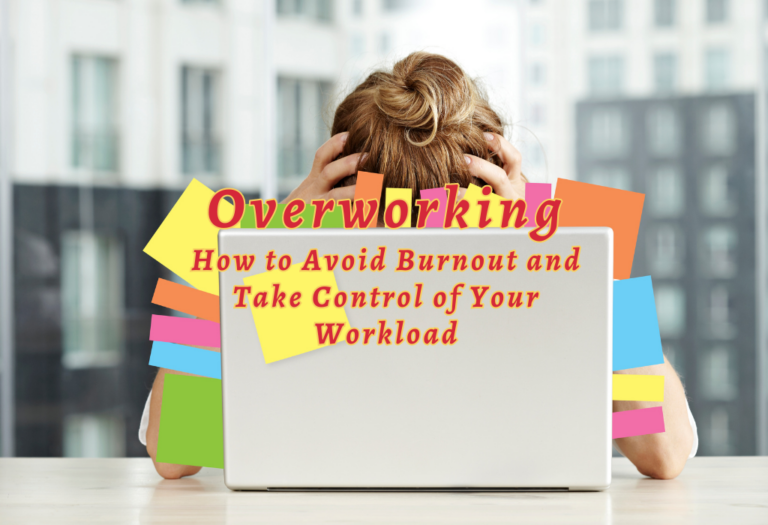Beat Procrastination: Tips and Tools for Busy Professionals
Do you ever feel like there are never enough hours in the day to accomplish everything on your list? If so, then procrastination could be a major factor. Procrastination can make us less productive and lead to missed deadlines or even worse – not reaching our goals at all.
It’s important to understand why we procrastinate and how it affects us, as well as develop strategies for overcoming it.
In this blog post, we’ll explore tips on identifying procrastination, overcoming it with time management techniques, and creating an effective work environment that sets you up for success.
We’ll also discuss ways of delegating responsibilities when necessary and using technology tools that help optimize productivity levels.

Identifying Procrastination
Procrastination is a common problem among busy professionals, entrepreneurs, and freelancers. It’s the act of delaying or postponing tasks that should be done to reach a goal. Procrastination can have serious consequences on productivity and success if it isn’t managed properly.
What is Procrastination?
Procrastination occurs when an individual delay doing something they know needs to be done to achieve their goals. This could include putting off completing assignments for school or work, avoiding difficult conversations with colleagues or clients, or even procrastinating on personal projects like starting a business or writing a book.
Signs of Procrastination
The following are typical indications of procrastination:
The more of these indications and symptoms you exhibit, along with their frequency and severity, the more likely you are to be a procrastinator, and the more severe your procrastination is likely to be.
Causes of Procrastination
People may delay action in the belief that they would feel better in the short term, even though procrastinating increases long-term stress.
Consistently, research demonstrates that procrastination increases our stress levels. There are many potential causes for procrastination.
It seems sensible that if you view a task to be monotonous or unpleasant, you will put it off until later.
Another reason you may delay tasks? You lack confidence in your skills. Having confidence in one’s ability to do things is crucial to functioning. If your self-efficacy is low, you are less likely to initiate and complete a task.
You may delay action out of dread. For instance, you may delay necessary medical examinations out of fear of a diagnosis. The greater our concern over a task, the more inclined we are to delay its completion.
In addition to increasing your stress level, this behavior poses a risk to your physical health due to an undiagnosed, untreated ailment.
The fear of being criticized or humiliated might delay the scheduling of meetings or the completion of projects.
Perfectionism is associated with procrastination. People may delay jobs they fear they will perform poorly or fail to complete entirely. They may delay a task until they feel more inspired or have a better idea, even though inspiration is more likely to arrive once a person begins a task.
Environmental distractions can keep us from concentrating on the task at hand. Many of us can relate to the allure of social media over unpleasant tasks like paying bills. In recent years, researchers believe procrastination has risen. Technology has played a role. Throughout history, procrastination has been described as human behavior.
Overcoming Procrastination
It’s the tendency to put off tasks, even when we know they should be done right away. It can lead to missed deadlines, poor performance, and feelings of guilt or shame. Fortunately, there are strategies for avoiding procrastination and getting back on track with your goals.
Strategies for Avoiding Procrastination:
The first step in overcoming procrastination is to identify what triggers it in you. Once you understand why you tend to procrastinate, it will be easier to develop strategies for avoiding it. Some effective strategies include breaking down large tasks into smaller ones; setting realistic goals; creating a timeline with specific deadlines; removing distractions like social media or TV; and rewarding yourself after completing each task.
To stay focused and motivated while working on a project or task, it can be helpful to use positive self-talk such as “I am capable of completing this”. Remind yourself of the advantages that come with finishing the job at hand – for instance, if you finish writing an article by Friday night then you will have more time over the weekend to relax and unwind. Additionally, don’t forget to take breaks throughout your workday so that your mind remains fresh and alert during extended periods of concentration.
By following the strategies, tips, and techniques for overcoming procrastination, you can increase your productivity and make better use of your time. Now let’s look at how to create a plan for managing your time more effectively.
Time Management Techniques
Time management is essential for busy professionals, entrepreneurs, and freelancers. Knowing how to prioritize tasks, set deadlines, and schedule breaks can help you stay on track with your goals.
Prioritizing Tasks
When it comes to managing your time effectively, prioritizing tasks is key. Start by making a list of all the things that need to be done and rank them in order of importance or urgency. This will help you focus on the most important tasks first while still allowing yourself time for less pressing items later on. For example, if you have an upcoming deadline at work but also want to take some time off this weekend, prioritize the deadline over planning your vacation so that it doesn’t interfere with meeting your obligations at work.
Setting Deadlines:
Setting deadlines can be a great way to motivate yourself and keep yourself accountable when tackling projects or tasks. Make sure that these deadlines are realistic; otherwise, they won’t be effective in helping you manage your time efficiently. Also, consider breaking up large projects into smaller chunks so that each task has its timeline instead of one long-term goal without any milestones along the way.
Time management techniques are essential for helping you stay focused and organized. By creating an effective work environment, you can maximize your productivity and efficiency.
Creating an Effective Work Environment
Developing a productive work environment is vital for maximizing productivity. Key components of this approach include minimizing distractions, developing routines and habits, and improving your workstation.
Minimizing Distractions:
To build a productive workplace, it is essential to limit potential distractions. This involves disabling notifications on phones and laptops that may distract concentration. It also involves avoiding multitasking if possible and concentrating on a single task till completion. Finally, attempt to reduce the amount of potentially distracting individuals in your workspace.
Establishing Routines and Habits:
Developing solid routines and habits can aid in maintaining attention while working from home or in an office throughout the day. Start by making a daily calendar that includes set times for emails, phone calls, meetings, etc., and then adhere to it. Additionally, divide major projects into smaller portions to make them less intimidating and easier to manage over time. Lastly, take frequent pauses throughout the day; these moments away from work can help you regain your energy so that you can return to your responsibilities with more concentration.
Setting up your workstation appropriately is crucial for being organized and effective during long hours spent working from home or in an office. Ensure there is sufficient natural light flowing in through windows, if possible; this reduces eye strain caused by staring at screens all day. In addition, put pens, pencils, and paperclips within easy reach so you don’t have to seek them every time you need anything tiny but essential, such as signing documents or taking notes during meetings, etc. Consider investing in ergonomic equipment, such as adjustable seats and desks, which provide support for correct posture while sitting for extended periods without causing discomfort due to improper alignment of body components such as the neck and shoulders.
Creating a productive work environment can help you remain focused and productive, allowing you to maximize your time. Now let’s examine how to delegate responsibilities to maximize your productivity even further.
Delegating Responsibilities
Delegating responsibilities is an important skill for busy professionals, entrepreneurs, and freelancers. It can help you optimize your schedule, increase productivity, and live a more fulfilling life. Here are some tips on how to delegate effectively:
Determining What to Delegate:
The first step in delegating responsibilities is determining which tasks can be delegated. Consider the skills required for each task and decide if it’s something that someone else could do better or faster than you. Think about what tasks take up too much of your time or energy and prioritize those when deciding what to delegate.
Finding the Right People to Delegate To:
Once you’ve identified which tasks need to be delegated, it’s time to find the right people for the job. Look for individuals who have experience with similar projects or who possess the necessary skillset needed for success. If possible, reach out to past colleagues or contacts who may be able to help out with specific tasks as well as any freelance websites where you can hire skilled workers quickly and easily at competitive rates.
Delegating responsibilities can help you stay on track and maximize productivity. By utilizing technology and tools, you can further increase your efficiency and measure progress.
Utilizing Technology and Tools
Technology and tools can be invaluable when it comes to increasing efficiency, productivity, and organization. Automation tools are a great way to streamline mundane tasks that take up valuable time. For example, scheduling software can help you quickly book appointments or meetings with clients without having to manually enter information into a calendar. Productivity apps also provide an easy way to track progress on projects and goals. These apps often come with features such as reminders, timers, task lists, analytics dashboards, and more. With these types of apps at your disposal, you’ll be able to easily monitor how much time is being spent on each task or project so that you can make adjustments accordingly to stay on track for success. Utilizing technology and tools not only saves time but also helps keep everything organized so that nothing falls through the cracks.
FAQs about Procrastination
We hope you found this short guide on procrastination useful. If you’re looking for more information on how to stop procrastinating and take action check out some faqs below:
Conclusion
Procrastination can be a major obstacle to achieving your goals, but it doesn’t have to be. By identifying procrastination and its triggers, overcoming it with techniques such as time management and creating an effective work environment, delegating responsibilities when necessary, and utilizing technology and tools that are available to you, you can overcome the habit of procrastination and become more productive in both your professional life and personal life. With dedication and perseverance, you will soon find yourself on the path toward success without having to worry about procrastination getting in the way.
Are you tired of procrastinating and struggling to stay productive? Schedule Makeover provides the expert tips, tools, and resources needed to help optimize your schedule, increase productivity, manage projects more effectively, and lead a more fulfilling life. With our easy-to-use platform that is tailored specifically for busy professionals like yourself, take control of your time today with Schedule Makeover!






